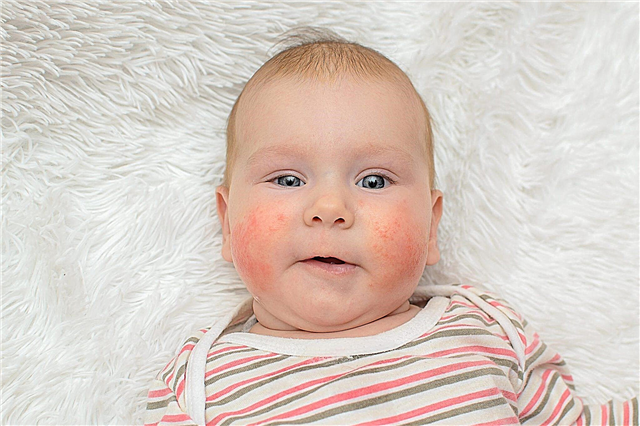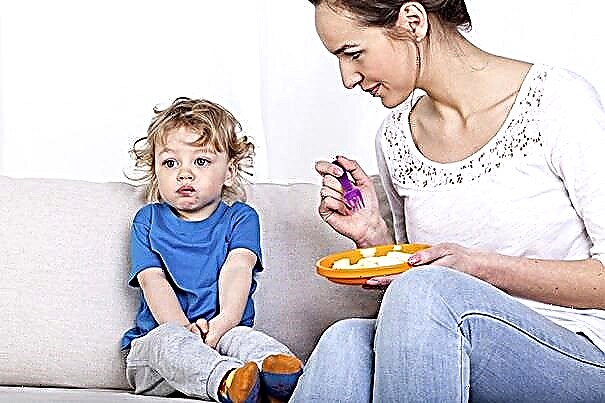The formation of red spots on the body of a toddler is a fairly common phenomenon. The reasons that can cause this problem are quite numerous. What factors can provoke red spots on the body of a child? What are the types of redness on the skin of a child? How to treat and prevent rashes? This article will answer these and other relevant questions.

Rash on the skin of a child
Why do red spots appear
In medicine, more than a hundred different diseases are distinguished that can cause red rashes in a child. These reasons practically do not differ from those that are typical for the adult population. Each pathology has a number of additional symptoms (in addition to the rash itself).
Interesting. The most common cause is an allergic reaction. In second place in popularity are viral diseases, for example, chickenpox, measles, scarlet fever, and so on.
Other reasons why skin may turn red include:
- Scabies;
- Leeshai;
- Molluscum contagiosum;
- Prickly heat;
- Insect bites;
- Hives;
- Erythema;
- Roseola for children;
- Sunburns (during long walks in the hot sun, especially after contact with water).
Shingles
The main reason for the development is infection with the varicella zoster virus in the presence of a weakened immune system. Both adults and children can be a source of infection. Pathology is transmitted in such ways:
- Contact, for example, when kissing, when infected saliva gets on the baby's skin.
- Household, through household items.
- Airborne.
- Transfusion, blood transfusion.
The disease begins to develop actively against the background of a decrease in the number of T-lymphocytes (which contain the infection). In newborn babies, the virus appears as a result of its transmission to the child through the placenta or breast milk, if the woman has had the disease in the third trimester.
A blistering red rash occurs on the intercostal area as well as mucous surfaces. Other symptoms include:
- The rash spreads all over the body;
- Signs of SARS or flu - fever, chills, swollen lymph nodes, lack of appetite, general malaise;
- Burning and itching at the site of the lesion, numbness and tingling are also felt;
- Pain in the area of the affected nerves.
Papules have a diameter of about 5 mm, are located closely to each other, are grouped. The seals contain a colorless liquid, which becomes cloudy after 1.5-2 days.
A severe form of the disease is characterized by the following symptoms:
- Hemorrhagic fever;
- Blistering and erosion on the skin and mucous surfaces;
- Gangrenous formations - a black scab in the place of papules, on which ulcers then appear.
Chicken pox
A fairly common infectious disease that is transmitted through contact with a carrier of the virus or an infected object.
Red spots appear on the child's skin, which gradually change into a different shape - itchy blisters. The foci of inflammation are localized in the armpits, between the fingers, on the feet and the oral mucosa. The rash itches, especially at night.
On a note. In young children, a significant increase in temperature is not always observed - the indicator only slightly crosses the 37 degrees mark. In some cases, the temperature does not rise at all.

Smallpox
Insect bites
One of the most common reasons for the appearance of red spots on a child's body is the bites of blood-sucking insects (mosquitoes, midges, bedbugs, ticks) and stinging (bees, wasps) insects. As a result, swellings are formed that itch and even hurt.
A rash in these cases is a reaction to a toxin entering the body. The spots are single, not numerous, and are scattered. The greatest danger is posed by wasp and bee stings, since they can provoke severe swelling and even the development of Quincke's edema.
Molluscum contagiosum
Viral pathology, usually found in infants. The formations have a genus of reddish round nodules the size of a small pea. They are dense to the touch.
At the beginning of the disease, one nodule appears. Over time, new peas appear. A large number of formations indicate a poor state of the body's immune defense.
Nodules do not cause problems, since they do not itch and do not hurt (even if touched). Usually, the disease goes away on its own without medical intervention.
Allergic reactions
Allergy is an increased sensitivity of the body to certain irritants (substances), which is expressed in a certain reaction, often in the form of the appearance of red spots on the body.
The rash can collect in certain areas or spread throughout the body. Allergies can be caused by such factors:
- Contact with household chemicals, bleach (for example, when swimming in the pool);
- Eating certain foods (milk, beef, veal - common irritants in childhood);
- Interaction with new things (toys, clothes, etc.);
- Animal wool;
- Plant pollen;
- Medications.
A type of local allergic reaction in children is prickly heat. It is characterized by the formation of a small rash that outwardly resembles a large rough-red spot. Causes of occurrence:
- Hot air in the nursery;
- Wearing synthetic clothing;
- Using creams in hot weather;
- Lack of hygiene (or rare procedures).
The rash does not bother the child (it does not itch, does not hurt).
Skin pathologies
Among the dermatological diseases, which are characterized by red rashes on the body, are eczema and hereditary psoriasis. Children may also have acne, which is localized, as a rule, on the cheeks, forehead, chin, and back of the baby. Acne in babies can appear from the day of birth until the baby is one month old.
Another fairly common dermatological disease in children (usually found in the maternity hospital on days 2-5 of life) is toxic erythema. It is characterized by the formation of small yellowish or white rashes on the red area of the skin. Localization is different. The rash goes away on its own after 2 weeks.

Baby acne
Infectious pathologies
Among the infectious diseases that can cause red rashes on the skin of a child are:
- Measles. Has such a description: it starts with a fever, runny nose, cough, conjunctivitis. On the 5th day, the body should be covered with many pink spots, which subsequently merge with each other into larger irregular spots.
- Rubella. Small pink spots of small size form on the body, spreading throughout the skin. The accumulation of spots is observed on the face, back, neck, shoulders, and chest of the baby.
- Scarlet fever. The throat starts to hurt, the temperature rises. On the 3rd day of the course of the disease, a small rash appears on the body, which causes severe itching. It is localized in the skin folds. On the 5th day, the skin turns pale, begins to peel off strongly.
- Infectious erythema. Shapeless red spots or a rash appear on the skin due to the rush of blood to the vessels. In the first days, the face becomes covered with a small rash, which gradually merges into a single red spot. Further, the redness spreads to the arms, legs, torso.
- Hives. It is expressed by red blisters on the body, which itch a lot.
- Roseola for children. First, the temperature rises and lasts for 4 days. When it subsides, rashes appear on the skin in the form of red spots of different sizes. Formations do not itch, do not hurt.
- Infectious mononucleosis. The disease is common in children under 10 years of age. The rash does not itch, it is represented by small reddish spots that affect the abdomen, arms, legs, chest, face. There is no need to treat the disease - the spots begin to disappear on their own.

Hives
Rash classification
A rash in a child can be presented:
- Spots. Do not protrude above the skin surface, have a different color;
- Blisters. An inflamed area of the skin formed as a result of edema of the upper layer of the dermis;
- Pustules (purulent blisters). Dense bulging mass with pus inside. After the pustule opens, a scar remains;
- Papules (nodules). It can have both soft and dense structure. Often, papules are combined into one group;
- Oval or round bubbles;
- Large blisters (bullae). They have a dense structure, filled with liquid;
- Bumps. Condensed dry formation.
Differential diagnosis
To make a diagnosis, combinations of the primary elements of skin modification are studied:
- Papules and plaques with scaling (symptoms of psoriasis, pink lichen, dermatitis);
- Papules around the hair follicles (signs of rosacea, acne, folliculitis);
- Inflammatory processes in the skin and subcutaneous tissue indicate urticaria, annular granuloma, etc.
- Blisters, pustules speak of autoimmune diseases, hyperkeratosis, the presence of herpes, allergies.
The survey should include the following procedures:
- General clinical analyzes;
- Scraping analysis;
- Study of feces for helminthiasis;
- Immunological research;
- Serological analysis;
- Coagulogram;
- Skin tests;
- Allergen test;
- Ultrasound of internal organs.

Visit doctor
Treatment features
After determining the cause of the irritation on the skin, the doctor prescribes the appropriate treatment. The first step is to change the diet: in order to normalize the metabolism and improve the work of the circulatory system, the child is recommended to significantly reduce the consumption of fatty and fried foods.
For the treatment of skin diseases, the doctor prescribes a comprehensive treatment that eliminates the cause of the pathology and reduces its external manifestation in the form of red rashes on the body and other symptoms.
Note. You need to contact a pediatrician, pediatric dermatologist, allergist or other specialist for medical help.
When to see a doctor
Since various infections are very often the cause of skin rashes, parents call a doctor at home. The child needs to measure the temperature, if it is elevated, the baby most likely has an infection. If the indicators are normal, then the cause may be incorrect or insufficient hygiene.
If you have severe symptoms, call an ambulance:
- The child has difficulty breathing;
- Loss of consciousness has occurred;
- Anaphylactic shock (a sharp drop in blood pressure, fainting, respiratory failure);
- High temperature that does not go astray;
- Chest pain.
Itchy and flaky spots
Before the examination, it is not recommended to smear the spots with any means that can change the characteristics of the rash and thereby blur the clinical picture and complicate the diagnosis.
After examination, the doctor may prescribe the use of local remedies in the form of creams, ointments, antihistamines (for example, Triderma).
How can stains be smeared?
After examining problem areas by a doctor, you can alleviate the patient's condition with folk remedies:
- If the rash is accompanied by itching, use antihistamine ointments, suspensions;
- Individual points can be greased with brilliant green or moistened with potassium permanganate;
- When peeling, inflammation, decoctions of medicinal herbs are used (based on chamomile, calendula, green tea, birch buds);
- Celandine and yarrow are used to reduce the rash.
These funds are used in combination with medications prescribed by a doctor.

Ointment Triderm
What is forbidden to do
In order not to worsen the condition of the child's skin, you should refrain from such actions:
- Use ointments and creams without consulting a doctor;
- Self-medicate, give medicine without a doctor's prescription;
- Comb and squeeze out acne, blisters, etc. (especially if the pathology is infectious).
Preventive measures
The main ways to prevent redness are:
- Compliance with hygiene rules;
- Exclusion of contact with allergens and carriers of infections;
- Correct diet of a nursing mother;
- Air access to the affected areas of the dermis;
Red spots on the baby's body can be a symptom of various diseases. For successful treatment, it is necessary to find out the cause of the pathology.



